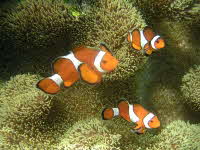CYANIDE FISHINGEarthTalk
(August 7, 2011) Dear EarthTalk: I heard of a practice called cyanide fishing, which is used mostly to collect aquarium specimens, but I understand it is also used to catch fish we eat. Isn’t this very unhealthy?
-- Phil Seymour, Albany, NY Cyanide fishing, whereby divers crush cyanide tablets into plastic squirt bottles of sea water and puff the solution to stun and capture live coral reef fish, is widely practiced throughout Southeast Asia despite being illegal in most countries of the region. The practice began in the 1960s in the Philippines as a way to capture live reef fish for sale primarily to European and North American aquarium owners—a market now worth some $200 million a year.  Pictured: The ocellaris clownfish, a popular aquarium fish often captured after first being stunned by bursts of cyanide-laced seawater squirted from a plastic bottle. Pictured: The ocellaris clownfish, a popular aquarium fish often captured after first being stunned by bursts of cyanide-laced seawater squirted from a plastic bottle.
Cyanide fishing began in the 1960s in the Philippines as a way to capture live reef fish for sale primarily to aquarium owners, but is today also done to supply specialty restaurants in Hong Kong and other large Asian cities.
Photo: Metatron
|
But today the technique is also used to supply specialty restaurants in Hong Kong and other large Asian cities. There high roller customers can choose which live fish they want prepared on the spot for their dinner at a cost of up to $300 per plate in what the non-profit World Resources Institute (WRI) calls “an essential status symbol for major celebrations and business occasions.” WRI adds that as the East Asian economy has boomed in recent decades, live reef food fish has become a trade worth $1 billion annually. Of course, the cyanide itself is no good for the fish that ingest it. Internet chat boards are rife with comments about cyanide-caught aquarium fish developing cancer within a year of being purchased. And many aquarium owners are willing to pay a premium for “net-caught” ornamental fish as they have a longer life expectancy. But perhaps the greater damage inflicted by cyanide fishing is to the coral reefs where it is employed, as cyanide kills the reefs and also many of the life forms that rely on them. Researchers estimate that more than a million kilograms of cyanide have been squirted onto Philippine reefs alone over the last half century. These days the practice is much more widespread, with some of the world’s most productive reefs being decimated.
“Despite the fact that cyanide fishing is nominally illegal in virtually all Indo-Pacific countries, the high premium paid for live reef fish, weak enforcement capacities, and frequent corruption have spread the use of the poison across the entire region—home o the vast majority of the planet’s coral reefs,” reports WRI. “As stocks in one country are depleted, the trade moves on to new frontiers, and cyanide fishing is now confirmed or suspected in countries stretching from the central Pacific to the shores of East Africa. Sadly, the most pristine reefs, far from the usual threats of sedimentation, coral mining and coastal development, are the primary target for cyanide fishing operations.” While there is not much evidence of cyanide-caught fish poisoning the people who eat it—the dose retained by a fish after being puffed is relatively small—the risk nevertheless remains, especially for those who ingest a lot of it. Nausea and gastritis are the typical symptoms of cyanide poisoning, and of course larger doses can cause death. WRI estimates that some 20 percent of the live fish for sale at markets across Southeast Asia are caught using cyanide. Children, the elderly and pregnant women should be especially careful to avoid cyanide-caught fish.
CONTACT: World Resources Institute, www.wri.org
EarthTalk® is written and edited by Roddy Scheer and Doug Moss and is a registered trademark of E - The Environmental Magazine (www.emagazine.com). Send questions to: earthtalk@emagazine.com Subscribe: www.emagazine.com/subscribe.
| 